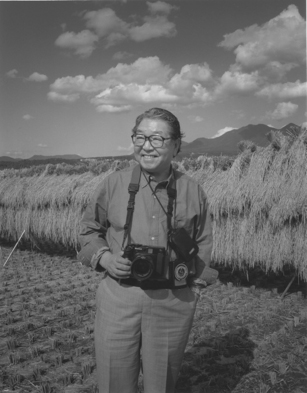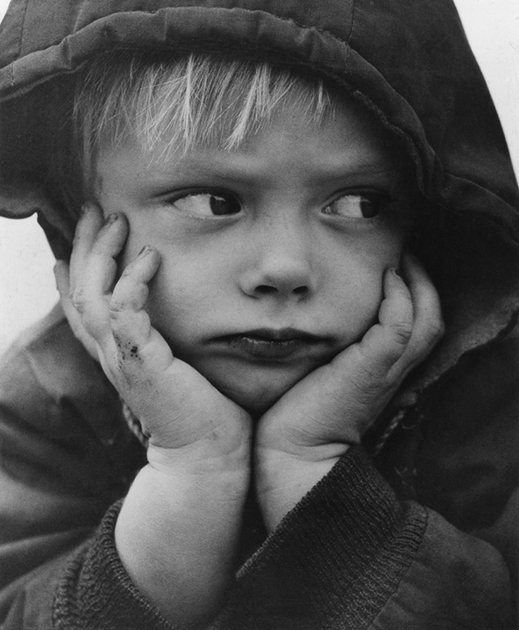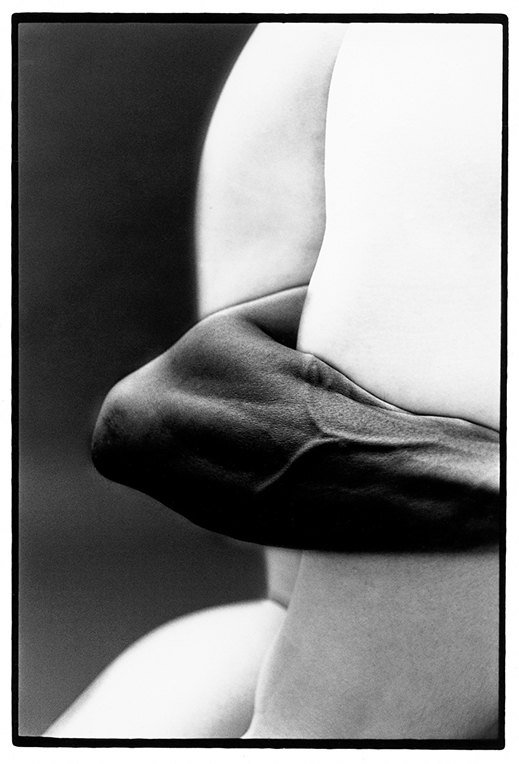| |
|
Here and There introduces art, artists, galleries, museums, and other cultural facilities around Japan that non-Japanese readers and first-time visitors may find of particular interest.
|
|
 |
|
|
 |
 |
Realm of the Senses: The Photography of Eikoh Hosoe
Alan Gleason |
 |
"Ordeal by Roses #32" (1961), © Eikoh Hosoe |
Eikoh Hosoe is one of the most eminent living members of a generation of shutterbugs who gave postwar Japanese photography worldwide cachet. Now 88, Hosoe has a gentle, professorial demeanor that belies his pivotal role in the avant-garde explosion in Japanese arts of the 1960s and 1970s. A friend to the novelist Yukio Mishima, the Butoh dance pioneers Tatsumi Hijikata and Kazuo Ohno, and other taboo-breaking luminaries of the day, he was instrumental in turning many of his cohorts into media celebrities through several series of intimate and sometimes controversial photographic portraits.
|
 |
|
|
|
Eikoh Hosoe. Photo by Kenji Hosoe
|
Hosoe's work during this period also gained a broad audience not least because it stood apart from the prevailing are-bure style of blurry, coarse-grained, spontaneously snapped imagery. Though he shared his contemporaries' penchant for high-contrast black-and-white work, Hosoe's photographs were more visually lucid and impeccably composed. Rather than challenge the conventions of the medium itself, he has always prioritized content. It is his subject matter, and the way he addresses it, that places him in the pantheon of the photographic avant-garde.
An extensive retrospective of Hosoe's oeuvre is now on view at the Kiyosato Museum of Photographic Arts (officially abbreviated as K*MoPA), where he has served as director since the museum opened in 1995. Its title, The Theatre Within a Dark Box, references Hosoe's likening of the camera to a room where a performance takes place -- a drama enacted between photographer and subject. It also dovetails with his de-emphasis of the photographer as the sole creative actor in the process. When one observes a subject through the viewfinder, he avers, the camera captures that subject's unique energy or essence in a process that is beyond the control of the person pressing the shutter. As the recipient and custodian of that energy, the photographer's role is thus relatively passive. The modesty of this conception is a natural outgrowth of Hosoe's self-effacing persona; throughout his career he has never been given to the posturing associated with the notion of photographer as artiste.
|
 |
|
|
|
"Poddie Jawoski" (1950), © Eikoh Hosoe. This is the work that earned Hosoe top prize in the Student Section of the 1951 Fuji Photo Contest.
|
Hosoe was born in 1933 in the northern prefecture of Yamagata, but grew up in Tokyo. In high school he joined the photography club and the English-language club. It was a portrait he took of a little girl living on the U.S. military base in Tokyo where he went to study English every week that won him his first photography prize, in 1951. That, he says, is when he decided to become a professional photographer.
In the late fifties, after graduating from the Tokyo College of Photography and finding work as a freelancer for photo and women's magazines, he began hanging out with other young photographers pushing the medium in new directions, among them Kikuji Kawada, Shomei Tomatsu, and Ikko Narahara. He also became fascinated with the Butoh performances of Tatsumi Hijikata and began to collaborate with the dancer on a brochure of photos that later appeared in Hosoe's first major collection, Man and Woman (1961). The book in turn got the attention of Yukio Mishima, who asked Hosoe to provide photographs for his book of essays The Assault of Beauty. Hosoe then asked Mishima to model for him, leading to the celebrated 1963 collection Killed by Roses (later translated as Ordeal by Roses). Rigorously choreographed by Hosoe, the Mishima portraits feature the writer naked or semi-naked in vaguely sadomasochistic poses, his body often festooned with the titular flowers. The work put Hosoe on the map once and for all, earning him international recognition and not a little notoriety at home.
 |
|
"Man and Woman #20" (1960), © Eikoh Hosoe |
In the 1960s Hosoe traveled to America and Europe, encountering the work of the Fluxus collective in New York and the architecture of Antoni Gaudi in Barcelona. He would continue to travel abroad yearly. Back in Japan, he took several trips with Hijikata to Akita, the latter's birthplace, adjacent to Hosoe's own home prefecture. These excursions produced another acclaimed series, Kamaitachi (1969), in which Hijikata plays the part of a demon who torments the inhabitants of a rural village. (The kamaitachi, or "sickle weasel," is a mythical creature of the region who attacks people with its sickle-like claws.) The local residents appear to have participated enthusiastically in the staging of these tableaux, and some of the most endearing shots are of old men and women on a break from work in the fields, laughing at Hijikata's mugging as he tells them a story.
"Kamaitachi #17" (1965), © Eikoh Hosoe |
|
 |
|
|
|
"Embrace #52" (1970), © Eikoh Hosoe
|
Hosoe's best-known works highlight his concerns with raw human emotions, especially those triggered by eroticism and death, as the charged images of Man and Woman and the Mishima series attest. This interest reached its apogee in Embrace (1971), a sequel of sorts (with text by Mishima) to Man and Woman that continued his exploration of sexuality. But his straightforward, unpretentious approach readily lent itself to other subjects, ranging from the architecture of Gaudi (a pet obsession of Hosoe) to the photos for a children's book by Betty Jean Lifton, Taka-chan and I: A Dog's Journey to Japan (1967). Some of his most affecting images are portraits of artists he was close to. The Kiyosato exhibition includes a number of series focusing on a particular individual: one is devoted to the cross-dressing dollmaker Simon Yotsuya, and another to the Butoh dancer Kazuo Ohno, an early collaborator with Hijikata who went on to develop his own idiosyncratic style and performed (even when wheelchair-bound) until his death at age 103.
 |
|
"Taka-chan and I" (1960), © Eikoh Hosoe |
For his part, Hosoe has persisted in his pursuit of the erotic muse well into his dotage. In the 1990s he conducted several workshops on nude photography while on visits to the United States. Luna Rossa (2000) is a collection of nudes photographed in bucolic settings in Alaska, Colorado, and upstate New York. What makes these works stand out, however, is not so much his treatment of the naked body as his active employment of experimental darkroom techniques like solarization and masking to produce some rather surreal collages, a style seen only sporadically in his past work.
|
"Tatsuhiko Shibusawa" from the series My Artist Friends (1965), © Eikoh Hosoe. Shibusawa was an author, critic, and translator of Jean Cocteau and Marquis de Sade who, like Hosoe, was close to Mishima and Hijikata.
|
|
"Sunflower Song, Snowmass, Colorado" from the series Luna Rossa (1992), © Eikoh Hosoe |
As director of K*MoPA, Hosoe remains engaged with the world of photography even in his late eighties. Among the projects he has spearheaded at the museum are its "Young Portfolios" program, which annually showcases photographers age 35 or younger, and a collection of platinum prints, products of an early photographic process that was once thought obsolete but which Hosoe extols for the richness of its monochrome tones. Evidently not content to rest on his "elder statesman" laurels, his undiminished enthusiasm for life behind the camera is an inspiration.
For more details on the museum and its activities, see this past Here and There review of a K*MoPA exhibition.
Eikoh Hosoe (right) leaps while snapping Tatsumi Hijikata (left) during one of the sessions for "Kamaitachi" (1968). Photo by Koji Fujii |
All photographic works by Eikoh Hosoe; all images courtesy of the Kiyosato Museum of Photographic Arts. |
 |
| Eikoh Hosoe: The Theatre Within a Dark Box (in Japanese only) |
| 17 July - 5 December 2021 |
| Kiyosato Museum of Photographic Arts (K*MoPA) |
3545-1222 Kiyosato, Takane-cho, Hokuto-shi, Yamanashi Prefecture
Phone: 0551-48-5599
Hours: 10 a.m. to 6 p.m. (last entry 30 minutes before closing)
Closed Tuesdays and from 6 December 2021 until mid-March 2022
Access: 10 minutes by taxi from Kiyosato Station on the JR Koumi Line, about 2 1/2 hours by train from Tokyo (transfer from the JR Chuo Line at Kobuchizawa); by car, 20 minutes from the Sutama Exit on the Chuo Expressway
|
|
|
|
| |
 |
Alan Gleason
Alan Gleason is a translator, editor and writer based in Tokyo, where he has lived for over 30 years. Since 2006 he has edited artscape Japan and written the Here and There column, as well as translating the Picks reviews. He also edits and translates works on Japanese architecture, music, and theater. |
|
|
|
|
|
|
|
|
|
 |
|